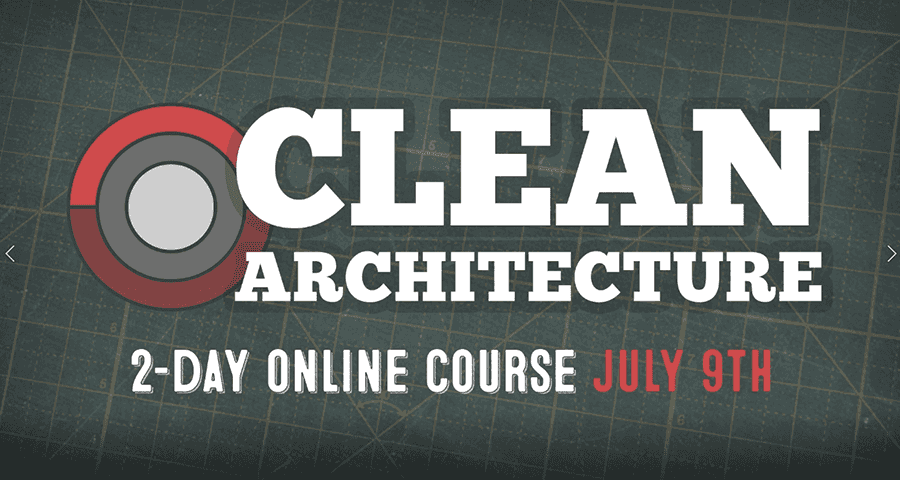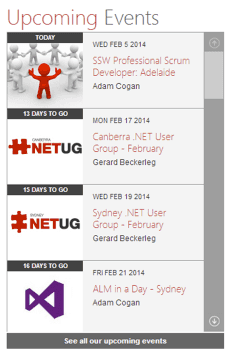Rules to Better Event Management - 23 Rules
Organizing an event is both rewarding and a lot of fun. There are a great number of things that you need to keep in mind though, when managing your event, whether it is a large conference, a user group or a once off launch of the latest product.
The below rules offer guidelines to help you create a professional, efficient and successful event that can be replicated and become a stable of your professional community. The rules are based on experience from community events, such as user groups, hackdays and conferences like DDD Melbourne, however, the rules can also be applied to commercial and large scale events.
The rules are split into three distinct sections:
- Before the event
- On the day
- After the event
The rules assume that your event idea has been properly researched and you have an audience for the particular field and topic you are addressing.
This cannot be stressed enough. The venue for your event is the absolute most important item to get right and to get locked in.
An ideal venue should be addressing all of the following
- Be able to accommodate the desired amount of people
- Offer appropriate audio and visual equipment for the talks, such as microphones, projectors and power sources
- Is there Wi-Fi available? If not, what is your backup plan (if any)
- Be within budgetary constraints (see rule "Have you got an adequate budget")
Securing the venue as early as possible on the right date allows you to
- Book in speakers – They can lock in the engagement
- Announce the venue
- Determine capacity – You now know how many attendees you can accommodate
- Start promoting the event
- Determine what approximate budget is needed
When planning an event, everything revolves around the date so it’s vital to be sure there are no potential clashes or conflicts. We recommend using a SharePoint calendar, to let employees and the public keep up to date with what your organisation is holding or attending. It is best to have more than 1 date in mind for your event when you start planning, as this affords you flexibility if your first choice of date won’t work out.
Be sure to check the dates and times of other events happening for that day. Depending on your event, it might also be worth looking for events on either side of your date, in case one of the events will be especially exhausting or costly, as this is likely to make people less interested in attending a second event right away.
Note: Events close to major holidays, i.e. Christmas, will often draw a smaller crowd and are more likely to need to be postponed
Securing the right speakers for the topic of your event ensures that you attract the right people who want to hear what your speakers have to say.
Depending on your level of ambition, you will have to get out early to book in your speakers. If you want to have speakers who are seen as authorities in their field, you will have to approach them many months in advance. It is not uncommon to book in speakers 6-12 months away from your event. In general
- Research the speakers for the topics you want – including watching previous talks and finding feedback from each speaker
- Determine the number of speakers – This can be a range such as 8-10
- Book speakers early – Popular speakers are booked out well in advance
-
Have backup speakers ready – cancellations can happen at any time
- This could be other speakers preparing more than one talk
-
Inform speakers of your expectations and provide any required information early
- This includes PowerPoint templates, sponsor logos and any venue-specific information
Having a minimum number for live events is important so everyone is on the same page. We find that a good minimum for live events is 6 people.
It is important not to cancel live events because people who have already registered become disappointed in the business and the business loses credibility. At times people who have already booked tickets, have also booked accommodation and air fares which causes additional pain to everyone. Having a reasonable number of attendees to attend each event will reduce these issues.
If you are running these events for lead generation purposes then not covering event costs with ticket sales isn't a problem. Additionally if you don't run a lead generation event you potentially lose the leads you have.
A successful event requires attendees to show up, or it won't reach its full potential. You will have to promote your event in a way that makes sense to your topic and approach.
The most cost-effective way is to use a large variety of online services that are available and to talk about the event.
Meetup
This is the best way to increase the discoverability of your event. Meetup provides the following:
- Allows people to search and discover events
- Allows people to join your group to get updates
- You can easily list your upcoming events and have people join them
- Comes with an automatic mailing list so you can send out announcements
Social Media
In some circumstances, it is worth setting up one or more accounts on social media for promoting and corresponding as the event identity. In technical circles, it is especially popular to use Twitter as a way to create awareness about events. SSW uses a combination of X, Facebook, LinkedIn, and Instagram to promote our events, that way we have a much larger and diverse audience to draw from.
Tip: Get your staff to tweet at events and to re-tweet your events to help reach a larger audience!
Word of Mouth
Don't underestimate the power of one friend or colleague telling another. DDD Melbourne sold out in 10 hours with almost no promotion except for Twitter and Word of Mouth. If you are creating a recurring event, Word of Mouth becomes extremely important as past experiences flow through the grapevine.
Putting on events aren’t free.
You need to pay for some or all of these
- Venue
- Catering
- Prizes
- Speaker expenses
- Attendee giveaways
- Printing of agendas, signs etc.
To raise the money for paying for these and to make the event a success you will have to get sponsors on board. To do this, find out what out what it is you are selling to potential sponsors:
- Do they get their branding on your website?
- Can they set up a booth at the venue?
- Is their logo or other material included in event communication?
- Can you share attendees' details (where they have permitted it)?
Sponsorship doesn't always have to be about cool hard cash. It can also include catering, prizes, giveaways, goody bags and much more. There are many ways sponsors can help your event, and it is up to you to determine what benefits you get out of each.
A good idea is to have levels of sponsorship such as gold, silver and bronze. This gives sponsors an option of joining at the level they feel comfortable with. It also has the side effect of potentially being able to upsell the sponsorship, if you have defined your levels well.
When you first start planning your event, a lot of ideas are put on the table and many are great and would improve your event.
However, you need to have a budget outlined, which you can then use to inform these decisions. The budget is generally made up of the expected sponsorship, but can also include grants, event fees and other income streams.
The budget should be revised if circumstances change. This can be due to lack of sponsorship, more attendees than expected or any other factor that has an influence on the budget.
Managing the process of selling tickets can be very time consuming if you try and do it on your own.
A much better approach is to use a service like EventBrite. SSW uses EventBrite for all events, as it allows you to manage all aspects of ticketing
- Selling
- Refunding
- Marketing
- Mailing lists
- Issuing more tickets
- And much more
Once you know which speakers you want and have established sponsorship and budget, you can start thinking about putting together an agenda.
It is another part of the event promotion and can have great influence on how your event is perceived and the type of audience you attract.
If you have multiple speakers for your event, it is a good idea to send a draft agenda to speakers and have them confirm their attendance and time. That way you can confidently publish the agenda with no further changes.
It is relatively easy to get volunteers for your event, but it is often something that is left until the last minute.
You need people to help you make everything happen. Unless you have attendees willing to pay lots of money for tickets, you won't have the luxury of paying staff to make the event happen.
Volunteers can come from many directions such as
- People interested in coming to the event and wanting to help out
- Other user groups where you yourself is volunteering
- Friends and colleagues
You can almost not have enough volunteers and with a bit of notice you shouldn't have any problems finding them.
If you are providing food and drinks for the attendees, this needs to be organized and confirmed.
Use the following checklist to ensure you get catering right.
- Dietary requirements – Are there any specific requirements, such as vegetarian, gluten-free, kosher, halal etc.? Are they visually labelled to avoid confusion for your event attendees?
- Is there adequate access to get the food and catering staff into the venue?
- Is there a designated area where food is served?
- Is the venue allowed to provide food for attendees?
Tip: You can make your event look like a million dollars by taking a little extra time and decanting your yummy offerings into nicer containers.
Looking forward to our #Brisbane #Chinafy Breakfast Experience today! If you need to modify your #app to work in #China and take advantage of 751 million users - get in touch! | https://t.co/IZz9Tb6jat pic.twitter.com/gh5alyQvmC
— SSW / SSW TV (@SSW_TV) July 3, 2018Figure: The Chinafy Breakfast in Sydney with yummy compotes made from yoghurt, granola and fruit
Arriving at a venue for the first time can be both confusing and daunting if you don't know the area. Your event should have a registration area clearly signposted and easily identifiable so that your guests can find you more easily.
Your registration process should be efficient and simple. What has worked well at DDD Melbourne is:
- Have enough people ready for registration first thing in the morning. More is more.
- Be able to find individual name tags and/or welcome packages quickly. Sorting alphabetically could be useful.
- Have a clear entry and exit so people aren't creating a bottleneck
- Use only electronic registration where possible. Eventbrite has an app linked to your account that will drastically speed up the process. So use an app where possible.
Attendees will go to the registration area to register (if applicable) and they will go here to have any questions answered as well. A registration area should be:
- Clearly visible – Put up adequate signage and announce where the area is
- Always manned – registration should have permanent staff there to help any attendees that require it at any time
- Brand your staff using company t-shirts, this will help people identify helpers immediately.
- Be at a central location, but not in the way of where people are walking
A successful event happens when all the actors know what their role is.
Have a list of tasks and jobs ready, which you can then distribute among the volunteers on the day. Update the list as tasks are identified throughout the day and make sure there is only one designated person that is in charge of the list.
If each volunteer know exactly what their job is, there is less standing around, less overlap between tasks and less time wasted. And more time for the volunteers means they can enjoy more of the event.
Make sure your event is well signposted, so your attendees can find not only the venue, but also important areas within it.
Your signage could include the following
- Directions from nearby transport, such as train stations and bus stops
- Registration area
- The agenda for the day to inform attendees of what is next
- Nearest toilets
- Room numbers (if the venue doesn't have that already)
If you have offered sponsors booth space, make sure you have a designated area they can be set up in.
Sponsors are likely to want access to the venue before the event starts. Make sure you take this into account when you plan the day. Possibly even get some volunteers to help sponsors get ready if they need it.
It is really important that your speakers feel empowered, so make sure you give them the tools they need to run their event well.
On the day of your event, chat to the speaker and give them the Speaker Checklist so they know how the day will run:
1. Agenda
Share the agenda with the audience, so they know the break times.
We recommend the following breaks:
Schedule Time Registration 9 am Morning tea 10:30 am (15 min) Lunch 1 pm - 2 pm Afternoon tea 3:30 pm (15 min) Finish 5 pm 2. Breaks
Attendees will often ask you what time the break will start or finish, so if you write it down they can refer it instead of asking you!
Tip: You can print out this PDF "Break-Ends-Sheet," to keep them informed, without answering the same question many times!
More info on Do you set a clear end time for breaks?
3. Names
Draw yourself a rough diagram of the room, start with intros and then go around the room and write people's names down for future reference. It will make speaking to them later a lot more personal if you can learn their name.
Tip: Draw the table layout before people arrive - it's faster. It's also easy if you draw the view you see looking at the audience.
!Figure: An example of the room layout with attendee's name, and memorable things about them
4. (Optional) Coffee Orders
- Ask attendees what coffee they would like, or ask them to fill out an electronic form and give this to your admin staff
5. Evaluations
- Share your evaluation forms out around 4 pm to give people time to complete them
Audience shots are great except when you don’t have a full house. In this case you should move people to be next to each other.
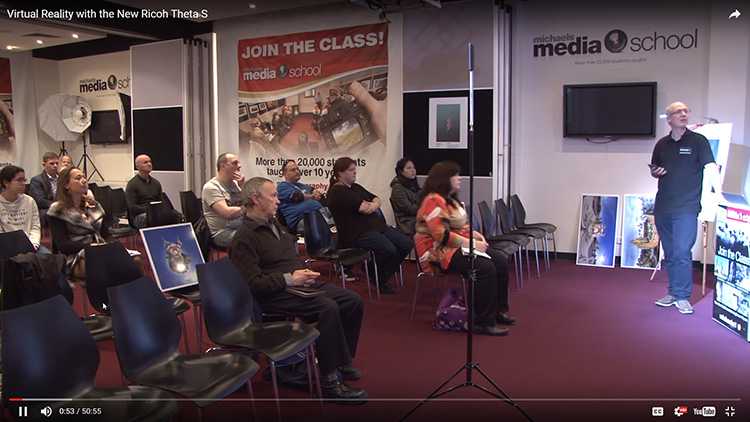
Figure: Bad example – The audience shot shows the bad numbers. It would be better to not use this view 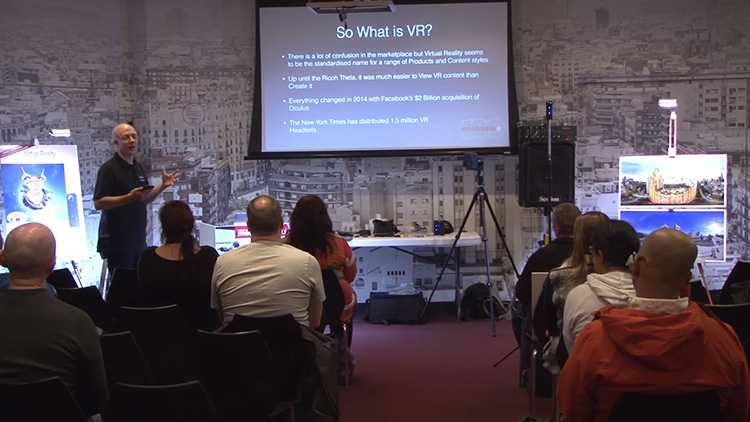
Figure: Bad example – The audience shot shows the bad numbers. You want to use this wide shot, but you need to make sure the attendees not in the shot are moved so their head is visible 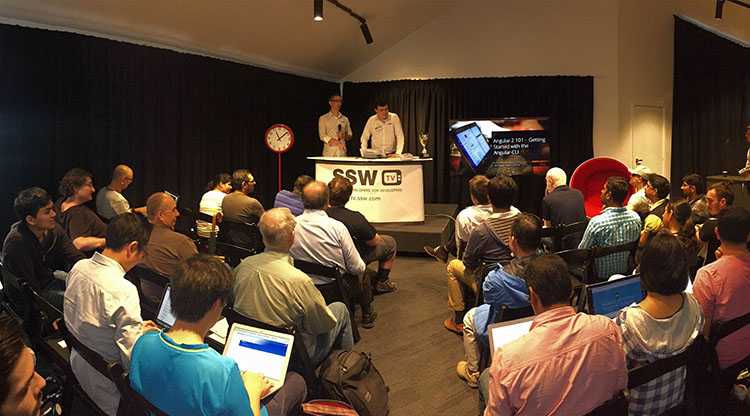
Figure: Good example – A shot from the SSW Chapel where the audience has been moved so they are in shot Tip: To ensure you get the best shot possible, fill seating from the front back. It's a good idea to use VIP signs and place them on the back row to prevent people sitting there initially. These can be moved later when all seats are filled at the front.

Figure: Using a VIP sign on the back row to prevent people sitting there initially In order to make your next event even better, you need to be able to collect feedback on the day from the people that were there.
There are a few options on how to collect the information.
- Set-up a QR code for people to scan which links to a Microsoft Form
- Set up an online survey using services like TypeForm
- Use an evaluation forms such as the one from SSW
Another great way to obtain feedback is to use a reward system: for example, at SSW after our events we organize QR codes for SSW Rewards App - where attendees can scan their attendance and obtain a number of points which they can use to claim prizes. We use the QR codes for feedback as another great incentive for our attendees to give their feedback so we can iterate and improve the experience for future events!
The best time to get attendees to fill out the feedback form is before the last session of the event. This is when people are still reasonably engaged and the people wanting to leave early haven't left yet.
Sometimes it is also worth getting attendees to evaluate individual speakers. This can be done with something as simple as red, yellow and green tokens to indicate how well a speaker did after each talk, or you can set up an elaborate online rating system. It really depends on what you are trying to achieve and what information you need.
Your attendees have all gone home with a mental boat load of information and great insights. Now is the time to follow them up and remind them of other events, how to keep in touch with you and where to find more information.
This does not need to be big sales pitch, but you do want to capitalize on your event being fresh in their mind.
Create a follow up strategy which could include:
- Adding attendees to a CRM for later follow up and communication (if they have agreed to do so)
- Send out a thank you email with more information such as
Dear XXX,
Thank you for joining us for breakfast and for the gift of your most precious resource - your time.
It was really great to meet you today and have the chance to discuss .NET development with you.
As per today's presentations, here are some useful links to you:
1. SSW TV - Videos by developers, for developers:http://tv.ssw.com
2. Webinar series - DevSuperPowers:http://www.devsuperpowers.com
3. https://www.facebook.com/SSW.page
Looking forward to hearing from you soon.
After the event it is also critical that you analyse the feedback. Why else would you be gathering it?
Look for trends in the data and evaluate what you can do better next time and what you should possibly leave out.
You should then send a retrospective email to relevant team members, and let them know how you feel the event went, and ask for their feedback.
Remember to include important feedback like:
- Any great comments from the evaluation forms
- Any not so great feedback from the evaluation forms
- Points for improvement
- Stats on the free demand generation (how 'Googleable' is your event)
- Stats on the paid demand generation (if applicable)
- The demand generation of the speaker (for example did they Tweet your event & what engagement did it get)
To maximize reusability and minimize costs, it’s best to avoid including dates as text in graphics for promotional videos.
If there is some particular value/purpose in including dates there may be exceptions to this rule.
Events such as training courses, user groups, tech breakfasts and boot camps can be a very useful way to get your highly skilled, impressive consultants in front of potential consulting clients.
You should make sure you have some upcoming events in each main area that you hope to get work from, preferably that showcase your core competencies well.
In events with multiple speakers clarity on the presentation order is crucial. Presenters need this to be ready to present at the right time, while attendees and the AV team benefit from knowing the flow.
Before the sessions begin, make a presentation run sheet and distribute it among the speakers, attendees, and AV team.
For those streaming the event, introduce the next speaker in the chat beforehand. This can enhance the stream experience by clearly segmenting the discussion for each presentation.
Tight schedules demand precise timing. Note the expected start time for each talk on the run sheet, helping everyone stay on track.
